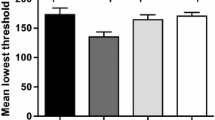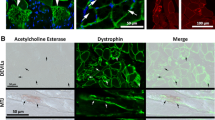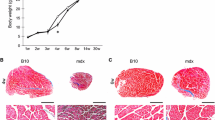Abstract
Lipofuscin, the so-called ageing pigment, is formed by the oxidative degradation of cellular macromolecules by oxygen-derived free radicals and redox-active metal ions. Usually it accumulates in post-mitotic, long-lived cells such as neurons and cardiac muscle cells. In contrast, it is rarely seen in either normal or diseased skeletal muscle fibres. In this paper, we report that lipofuscin accumulates at an early age in both human and murine dystrophic muscles. Autofluorescent lipofuscin granules were localized, using confocal laser scanning microscopy and electron microscopy, in dystrophin-deficient skeletal muscles of X chromosome-linked young Duchenne muscular dystrophy (DMD) patients and of mdx mice at various ages after birth. Age-matched normal controls were studied similarly. Autofluorescent lipofuscin granules were observed in dystrophic biceps brachii muscles of 2–7-year-old DMD patients where degeneration and regeneration of myofibres are active, but they were rarely seen in age-matched normal controls. In normal mice, lipofuscin first appears in diaphragm muscles nearly 20 weeks after birth but in mdx muscles it occurs much earlier, 4 weeks after birth, when the primary degeneration of dystrophin-deficient myofibres is at a peak. Lipofuscin accumulation increases with age in both mdx and normal controls and is always higher in dystrophic muscles than in age-matched normal controls. At the electron microscopical level, it was confirmed that the localisation of autofluorescent granules observed by light microscopy in dystrophin-deficient skeletal muscles coincided with lipofuscin granules in myofibres and myosatellite cells, and in macrophages accumulating around myofibres and in interstitial connective tissue. Our results agree with previous biochemical and histochemical data implying increased oxidative damages in DMD and mdx muscles. They indicate that dystrophin-deficient myofibres are either more susceptible to oxidative stress, or are subjected to higher intra- or extracellular oxidative stress than normal controls, or both.
Similar content being viewed by others
References
Beregi E, Regius O, Hüttl T, Göbl Z (1988) Age-related changes in the skeletal muscle cells. Z Gerontol 21: 83-86.
Brenman JE, Chao DS, Xia H, Aldape K, Bredt DS (1995) Nitric oxide synthase complexed with dystrophin and absent from skeletal muscle sarcolemma in Duchenne muscular dystrophy. Cell 82: 743-752.
Bulfield G, Siller WG, Wight PAL, Moore KJ (1984) X chromosome-linked muscular dystrophy (mdx) in the mouse. Proc Natl Acad Sci USA 81: 1189-1192.
Chang W-J, Iannaccone ST, Lau KS, Masters BSS, McCabe TJ, McMillan K, Padre RC, Spencer MJ, Tidball JG, Stull JT (1996) Neuronal nitric oxide synthase and dystrophin-deficient muscular dystrophy. Proc Natl Acad Sci USA 93: 9142-9147.
Chao DS, Silvagno F, Bredt DS (1998) Muscular dystrophy in mdx mice despite lack of neuronal nitric oxide synthase. J Neurochem 71: 784-789.
Crosbie RH, Straub V, Yun H-Y, Lee JC, Rafael JA, Chamberlain JS, Dawson VL, Dawson TM, Campbell KP(1998) Mdx muscle pathology is independent of nNOS perturbation. Hum Mol Genet 7: 823-829.
Darley-Usmar V, Wiseman H, Halliwell B (1995) Nitric oxide and oxygen radicals: A question of balance. FEBS Lett 369: 131-135.
Disatnik M-H, Dhawan J, Yu Y, Beal MF, Whirl MM, Franco AA, Rando TA (1998) Evidence of oxidative stress in mdx mouse muscle: Studies of the pre-necrotic state. J Neurol Sci 161: 77-84.
Disatnik M-H, Chamberlain JS, Rando TA (2000) Dystrophin mutations predict cellular susceptibility to oxidative stress. Muscle Nerve 23: 784-792.
Dupont-Versteegden EE, McCarter RJ (1992) Differential expression of muscular dystrophy in diaphragm versus hindlimb muscles of mdx mice. Muscle Nerve 15: 1105-1110.
Engel AG, Banker BQ (1994) Ultrastructural changes in diseased muscle. In: Engel AG, Franzini-Armstrong C, eds. Myology: Basic and Clinical. Vol. 1, 2nd edn. New York: McGraw-Hill, pp. 889-1017.
Faist V, Koenig J, Hoeger H, Elmadfa I (1998) Mitochondrial oxygen consumption, lipid peroxidation and antioxidant enzyme systems in skeletal muscle of senile dystrophic mice. Pflügers Arch-Eur J Physiol 437: 168-171.
Faist V, König J, Höger H, Elmadfa I (2001) Decreased mitochondrial oxygen consumption and antioxidant enzyme activities in skeletal muscle of dystrophic mice after low-intensity exercise. Ann Nutr Metab 45: 58-66.
Grozdanovic Z, Gosztonyi G, Gossrau R (1996) Nitric oxide synthase I (NOS-I) is deficient in the sarcolemma of striated muscle fibres in patients with Duchenne muscular dystrophy, suggesting an association with dystrophin. Acta Histochem 98: 61-69.
Haycock JW, Neil SM, Jones P, Harris JB, Mantle D (1996) Oxidative damage to muscle protein in Duchenne muscular dystrophy. NeuroReport 8: 357-361.
Hoffman EP, Brown RH, Kunkel LM (1987) Dystrophin: The protein product of the Duchenne muscular dystrophy locus. Cell 51: 919-928.
Ikeda H, Tauchi H, Sato T (1985) Fine structural analysis of lipofuscin in various issues of rats of different ages. Mech Ageing Dev 33: 77-93.
Kameya S, Miyagoe Y, Nonaka I, Ikemoto T, Endo M, Hanaoka K, Nabeshima Y, Takeda S (1999) á 1-syntrophin gene disruption results in the absence of neuronal-type nitric-oxide synthase at the sarco-lemma but does not induce muscle degeneration. J Biol Chem 274: 2193-2200.
Kárpáti G, Carpenter S, Wolfe LS (1988) Clinical and experimental studies on lipofuscin in skeletal muscle fibres. In: Zs-Nagy I, ed. Lipofuscin-1987: State of the Art, Budapest: Akadémiai Kiadò and Amsterdam: Elsevier Science Publishers, pp. 227-244.
Kelley EE, Wagner BA, Buettner GR, Burns CP (1999) Nitric oxide inhibits iron-induced lipid peroxidation in HL-60 cells. Arch Biochem Biophys 370: 97-104.
Laule S, Bornemann A (2001) Ultrastructural findings at the satellite cell-myofibre border in normal and diseased human muscle biopsy specimens. Acta Neuropathol 101: 435-439.
Louboutin JP, Fichter-Gagnepain V, Thaon E, Fardeau M (1993) Morphometric analysis of mdx diaphragm muscle fibres. Comparison with hindlimb muscles. Neuromuscul Disord 3: 463-469.
Louboutin J-P, Rouger K, Tinsley JM, Halldorson J, Wilson JM (2001) iNOS expression in dystrophinopathies can be reduced by somatic gene transfer of dystrophin or utrophin. Mol Med 7: 355-364.
Mastaglia FL, Papadimitriou JM, Kakulas BA (1970) Regeneration of muscle in Duchenne muscular dystrophy: An electron microscope study. J Neurol Sci 11: 425-444.
McKelvie P, Friling R, Davey K, Kowal L (1999) Changes as the result of ageing in extraocular muscles: A post-mortem study. Aust NZ J Ophthalmol 27: 420-425.
Murphy ME, Kehrer JP (1989) Oxidative stress and muscular dystrophy. Chem Biol Interact 69: 101-173.
Nakae Y, Stoward PJ, Shono M, Matsuzaki T (1999) Localisation and quantification of dehydrogenase activities in single muscle fibres of mdx gastrocnemius. Histochem Cell Biol 112: 427-436.
Nakae Y, Stoward PJ, Shono M, Matsuzaki T (2001) Most apoptotic cells in mdx diaphragm muscle contain accumulated lipofuscin. Histochem Cell Biol 115: 205-214.
Petrof BJ, Shrager JB, Stedman HH, Kelly AM, Sweeney HL (1993) Dystrophin protects the sarcolemma from stresses devel-oped during muscle contraction. Proc Natl Acad Sci USA 90: 3710-3714.
Ragusa RJ, Chow CK, Porter JD (1997) Oxidative stress as a potential pathogenic mechanism in an animal model of Duchenne muscular dystrophy. Neuromuscul Disord 7: 379-386.
Rando TA, Disatnik M-H, Yu Y, Franco A (1998) Muscle cells from mdx mice have an increased susceptibility to oxidative stress. Neuromuscul Disord 8: 14-21.
Roth SM, Martel GF, Ivey FM, Lemmer JT, Metter EJ, Hurley BF, Rogers MA (2000) Skeletal muscle satellite cell populations in healthy young and older men and women. Anat Rec 260: 351-358.
Schnell SA, Staines WA, Wessendorf MW (1999) Reduction of lipofuscin-like autofluorescence in fluorescently labeled tissue. J Histochem Cytochem 47: 719-730.
Schultz E (1976) Fine structure of satellite cells in growing skeletal muscle. Am J Anat 147: 49-70.
Stedman HH, Sweeney HL, Shrager JB, Maguire HC, Panettieri RA, Petrof B, Narusawa M, Leferovich JM, Sladky JT, Kelly AM (1991) The mdx mouse diaphragm reproduces the degenerative changes of Duchenne muscular dystrophy. Nature 352: 536-539.
Terman A, Brunk UT (1998a) Lipofuscin: Mechanisms of formation and increase with age. APMIS 106: 265-276.
Terman A, Brunk UT (1998b) On the degradability and exocytosis of ceroid/lipofuscin in cultured rat cardiac myocytes. Mech Ageing Dev 100: 145-156.
Wehling M, Stull JT, McCabe TJ, Tidball JG (1998) Sparing of mdx extraocular muscles from dystrophic pathology is not attributable to normalized concentration or distribution of neuronal nitric oxide synthase. Neuromuscul Disord 8: 22-29.
Wehling M, Spencer MJ, Tidball JG (2001) Anitric oxide synthase trans-gene ameliorates muscular dystrophy in mdx mice. J Cell Biol 155: 123-131.
Wink DA, Hanbauer I, Krishna MC, DeGraff W, Gamson J, Mitchell JB (1993) Nitric oxide protects against cellular damage and cyto-toxicity from reactive oxygen species. Proc Natl Acad Sci USA 90: 9813-9817.
Yin D (1996) Biochemical basis of lipofuscin, ceroid, and age pigment-like fluorophores. Free Rad Biol Med 21: 871-888.
Zhuang W, Eby JC, Cheong M, Mohapatra PK, Bredt DS, Disatnik M-H, Rando TA (2001) The susceptibility of muscle cells to oxidative stress is independent of nitric oxide synthase expression. Muscle Nerve 24: 502-511.
Author information
Authors and Affiliations
Rights and permissions
About this article
Cite this article
Nakae, Y., Stoward, P.J., Kashiyama, T. et al. Early Onset of Lipofuscin Accumulation in Dystrophin-Deficient Skeletal Muscles of DMD Patients and mdx Mice. Histochem J 35, 489–499 (2004). https://doi.org/10.1023/B:HIJO.0000045947.83628.a7
Issue Date:
DOI: https://doi.org/10.1023/B:HIJO.0000045947.83628.a7




